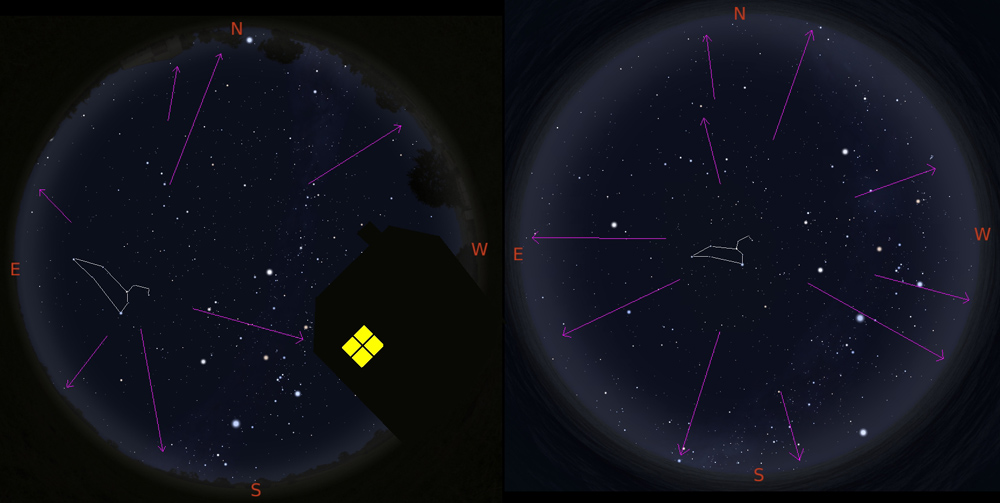ZHR – Zenithal Hourly Rate
Zenithal Hourly Rate (ZHR) is a term used in the observations of meteors. When a meteor shower reaches maximum activity, the number of meteors that will be seen per hour is given as a ZHR value. This is when an observer will in the best place and possible observing conditions to see meteors. The best place to see the meteor radiant is when it passes directly overhead. The best conditions are when the sky is very transparent with no mist or clouds. There is no moon light or light pollution. Also, there are no obstructions to the whole sky.
In
the above image, the left side shows what a typical observer
may have to contend with when making observations. In this
case, we are looking at the Leonid meteor shower that peaks
around 17th
November. The radiant is in
the “Sickle” of the Leo asterim. There may be an
obstruction like the house to the south west. There may be
partial cloud cover. The radiant is not overhead, which will
be the case most of the time. Some meteors will appear out
of view as they travel across the sky that is below the
eastern horizon.
The right image shows the ideal condition. In this case, the observer has gone to the trouble of getting directly underneath the radiant by rowing out to sea and positioning himself/herself at 22° north latitude. At this latitude, the radiant will pass overhead. (Admittedly, in reality the sky will have become bright when the radiant reaches the zenith on the 17th November!). It will be noticed that in the ideal place for observing, you will see more meteors as there are no obstructions hiding some of the meteors.
As most observers will never be in the place that will allow the maximum number of meteors to be seen, you have to make adjustments to realise how many meteors you will likely to see. Firstly, if half the sky is obstructed, then the ZHR will be halved. The radiant altitude will also affect the numbers. A rough calculation of the number of meteors that can be seen when the altitude of the radiant is taken into account by the dividing the quoted ZHR value by the radiant elevation correction factor R
R = 1/sin a
where a = radiant elevation in the sky.
Example. You are observing the Leonid meteors from the IoMAS Observatory (Lat. 54.2°N Long.4.6° W) and its 4 am. At this time, the meteor radiant is at an elevation of about 46°
If the ZHR is 20, then the number of meteors that you may expect to see is:-
ZHR/(R) = 20/(1/sin46) = 14.39 i.e., 14 meteors per hour.
Bibliography
Observer's Handbook Meteors by Neil Bone. Phillip's 1993
Norton's 2000 Edited by Ian Ridpath. Longman Scientific Technical. 1989
